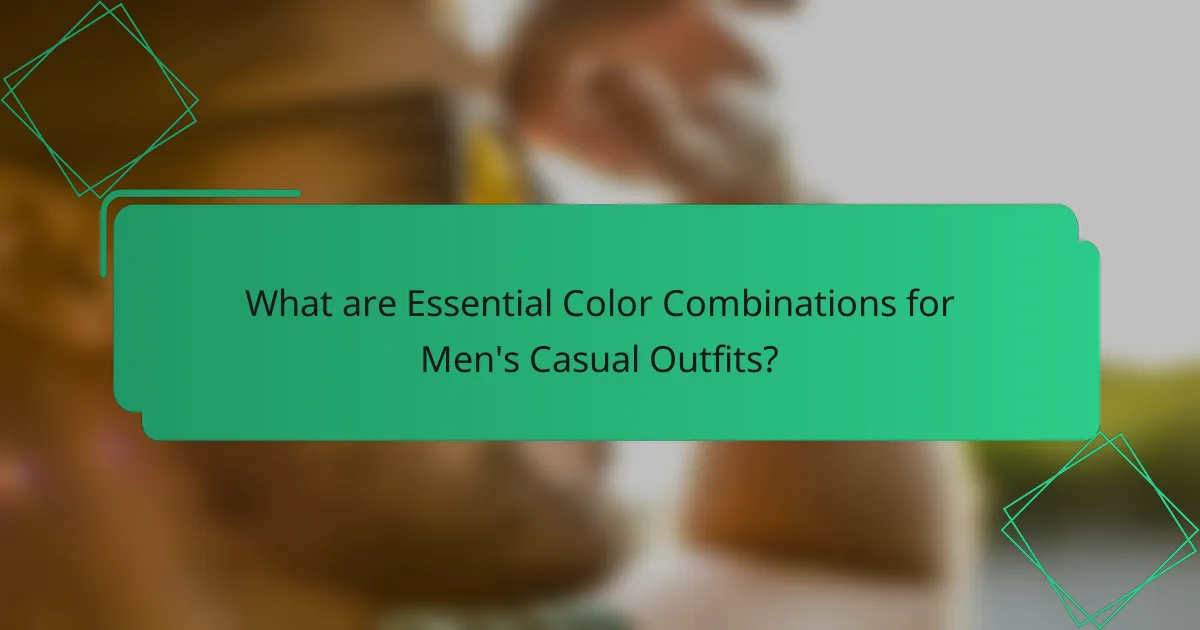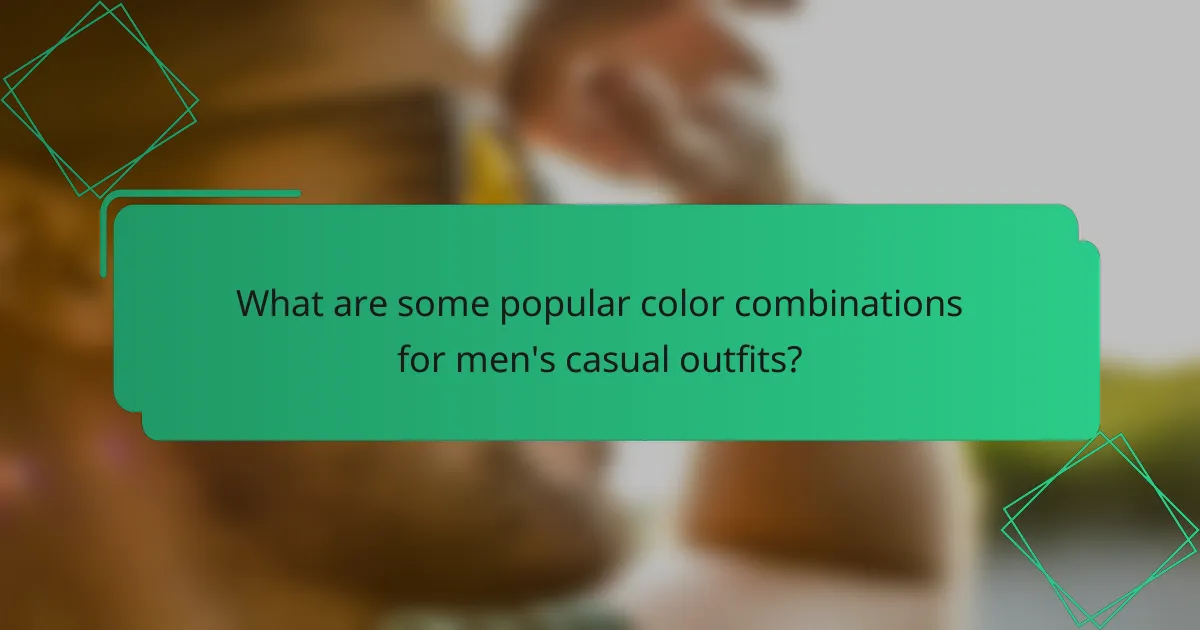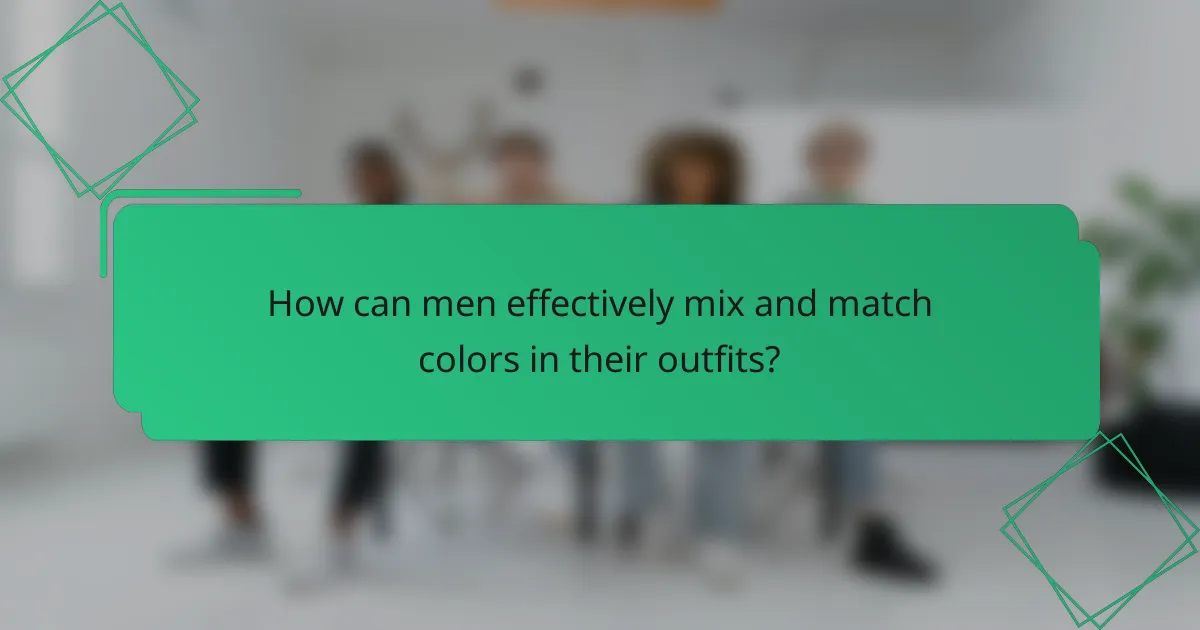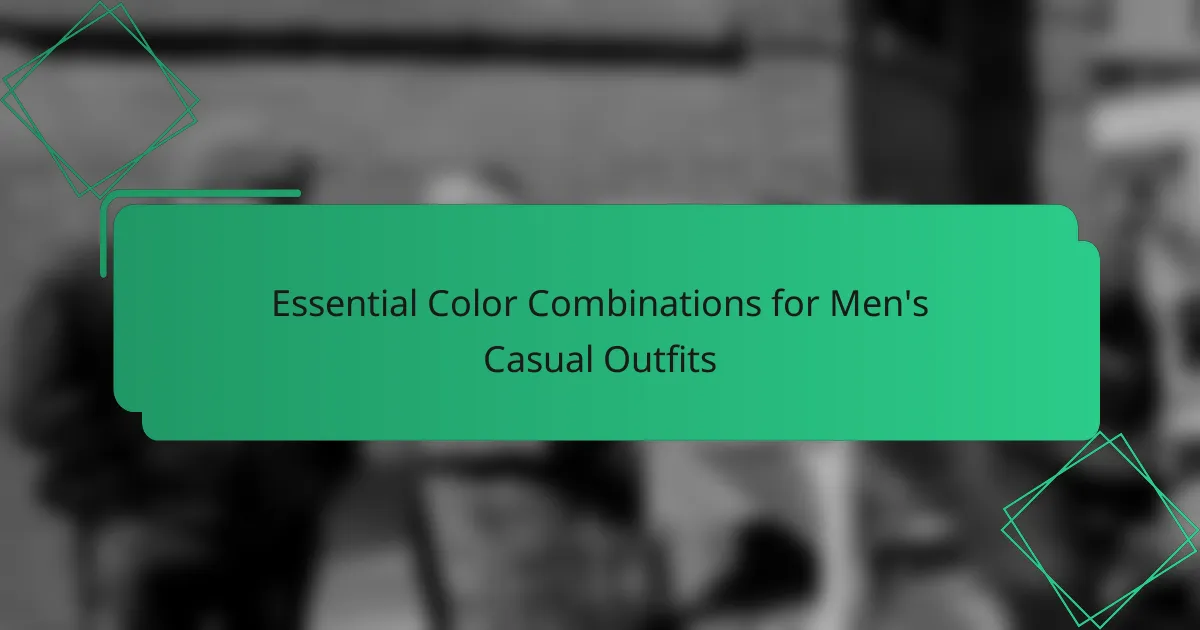Essential color combinations for men’s casual outfits include navy and white, gray and black, olive and beige, and burgundy and cream. Each combination offers distinct aesthetics suitable for various occasions, ranging from classic and versatile looks to modern and sleek styles. The article explores how to effectively mix and match colors using the color wheel, emphasizing the use of complementary and analogous colors. It also highlights the importance of neutral colors for balance and introduces the 60-30-10 rule for color distribution to enhance personal style and confidence. Understanding these key concepts can help men create cohesive and stylish outfits.

What are Essential Color Combinations for Men’s Casual Outfits?
Essential color combinations for men’s casual outfits include navy and white, gray and black, olive and beige, and burgundy and cream. Navy and white create a classic, nautical look that is versatile for various occasions. Gray and black offer a sleek, modern aesthetic suitable for urban settings. Olive and beige provide a natural, earthy vibe ideal for outdoor events. Burgundy and cream add a touch of sophistication while remaining casual. These combinations are widely recognized in fashion for their appeal and versatility.
Why are color combinations important in men’s casual fashion?
Color combinations are important in men’s casual fashion because they influence style perception and personal expression. Effective color pairings can enhance visual appeal and create a cohesive look. Research shows that color can affect mood and confidence. For instance, wearing complementary colors can attract positive attention. Additionally, understanding color theory helps in making informed choices. Men who master color combinations often stand out in social settings. This knowledge can lead to improved first impressions. Overall, strategic color use is essential for a polished and fashionable appearance.
How do color combinations affect overall style and appearance?
Color combinations significantly influence overall style and appearance. They can create harmony or contrast in an outfit. Harmonious combinations often evoke a sense of balance and cohesion. For example, analogous colors, like blue and green, work well together. They enhance a relaxed and pleasing aesthetic. In contrast, complementary colors, such as blue and orange, create visual interest and energy. This can make an outfit stand out. Additionally, color combinations can affect perceptions of mood and professionalism. Studies show that colors can evoke specific emotions, impacting how one is perceived. Thus, selecting the right color combinations is crucial for effective style and appearance.
What role do colors play in expressing personal style?
Colors significantly influence personal style by conveying mood and personality. They serve as a visual language that communicates individual identity. For instance, warm colors like red and orange can express confidence and energy. In contrast, cool colors such as blue and green often evoke calmness and tranquility.
Research shows that color choices can affect perceptions. A study by the Institute for Color Research found that people make judgments about a person or environment within 90 seconds based on color alone. This highlights the importance of color in style expression.
Additionally, colors can enhance or detract from an outfit’s appeal. Complementary color combinations can create a cohesive look, while clashing colors may lead to a disjointed appearance. Therefore, understanding color theory is essential for effective personal style expression.
What are the basic principles of color theory in fashion?
The basic principles of color theory in fashion include the color wheel, color harmony, and the impact of color on perception. The color wheel organizes colors into primary, secondary, and tertiary categories. Primary colors are red, blue, and yellow. Secondary colors are green, orange, and purple, created by mixing primary colors. Tertiary colors result from mixing primary and secondary colors.
Color harmony refers to aesthetically pleasing combinations of colors. Complementary colors are opposite each other on the color wheel. They create a vibrant contrast when used together. Analogous colors are next to each other on the wheel. They provide a more subtle and harmonious look.
The impact of color on perception is significant in fashion. Colors can evoke emotions and influence mood. For example, blue often conveys calmness, while red can signify energy. Understanding these principles helps in making informed fashion choices.
What are primary, secondary, and tertiary colors?
Primary colors are red, blue, and yellow. These colors cannot be created by mixing other colors. Secondary colors are green, orange, and purple. They are formed by mixing two primary colors. Tertiary colors are the result of mixing a primary color with a secondary color. Examples include red-orange and blue-green. This classification is fundamental in color theory. It helps understand color mixing and combinations in various applications, including fashion.
How do complementary and analogous colors work?
Complementary colors are pairs of colors that are opposite each other on the color wheel. They create high contrast and vibrant looks when used together. For example, blue and orange are complementary colors. This combination can make outfits stand out.
Analogous colors are groups of three colors that are next to each other on the color wheel. They create a harmonious and cohesive look. For instance, blue, blue-green, and green are analogous colors. This combination provides a more subtle and blended appearance.
Using complementary colors can enhance visual interest in casual outfits. It draws attention and can highlight specific elements of an outfit. Conversely, analogous colors offer a more relaxed vibe. They can create a smooth transition between shades, making outfits feel more unified.

What are some popular color combinations for men’s casual outfits?
Popular color combinations for men’s casual outfits include navy and white, gray and black, and olive green with beige. Navy and white create a classic and clean look, ideal for various occasions. Gray and black provide a sleek and modern appearance, suitable for urban settings. Olive green paired with beige offers a relaxed and earthy vibe, perfect for outdoor activities. Other combinations like burgundy and gray or light blue with khaki are also favored for their versatility and style. These combinations reflect current fashion trends and can be easily adapted to personal preferences.
What are classic color combinations that never go out of style?
Classic color combinations that never go out of style include navy and white, black and white, and gray and black. Navy and white create a timeless nautical look. Black and white offer a sophisticated contrast suitable for various occasions. Gray and black provide a modern, sleek aesthetic. These combinations have stood the test of time in fashion. They are often used in men’s casual outfits for their versatility and elegance. Historical fashion trends consistently feature these pairings. Designers frequently incorporate them into collections, reinforcing their enduring appeal.
How can navy blue and white be styled together?
Navy blue and white can be styled together through various combinations in clothing and accessories. For a classic look, pair a navy blue blazer with a white shirt. This creates a sharp, professional appearance suitable for casual outings. Another option is to wear navy blue chinos with a white t-shirt. This combination is comfortable and stylish for everyday wear.
In addition, navy blue and white striped patterns can be used in shirts or sweaters. Stripes add visual interest while maintaining a cohesive color scheme. Accessories like a navy blue belt or shoes can further enhance the outfit.
Using these combinations is supported by fashion guidelines that emphasize the versatility of navy blue and white. This color pairing is timeless and works well in various settings, from casual to semi-formal.
What makes gray and black a timeless pairing?
Gray and black form a timeless pairing due to their versatility and complementary nature. Both colors are neutral, allowing them to blend seamlessly with various other hues. This combination creates a sophisticated and modern aesthetic. Gray softens the starkness of black, while black adds depth to gray. Historically, this pairing has been favored in fashion and design for its elegance. Many designers utilize gray and black to evoke a sense of professionalism and style. The enduring appeal of this color duo is evident in both casual and formal attire. This consistent usage in fashion trends reinforces its timeless status.
What trendy color combinations should men consider?
Men should consider trendy color combinations such as navy and olive, gray and burgundy, and black and mustard. Navy and olive create a sophisticated yet relaxed look, ideal for casual outings. Gray and burgundy offer a rich contrast, perfect for autumn wear. Black and mustard provide a bold statement, making outfits stand out. These combinations enhance versatility in men’s casual wardrobes. Fashion experts frequently recommend these pairings for their modern appeal and ability to complement various skin tones.
How can earth tones be incorporated into casual outfits?
Earth tones can be incorporated into casual outfits by mixing shades like beige, olive, and rust. Pairing a beige shirt with olive chinos creates a balanced look. Adding rust-colored sneakers can provide a pop of color. Layering with a brown jacket enhances the earthy aesthetic. Accessories like a tan belt or a green cap can complete the outfit. Earth tones are versatile and easy to match. They work well with denim and other neutral colors. This combination promotes a relaxed and natural vibe.
What are the benefits of using pastel colors in casual wear?
Pastel colors in casual wear offer several benefits. They create a soft and calming aesthetic. This can enhance the overall mood of the wearer and those around them. Pastel shades are often associated with spring and summer, making them seasonally appropriate. They provide versatility, easily pairing with neutral tones for a balanced look. Additionally, pastel colors can highlight personal style without being overly bold. Studies show that lighter colors can make individuals appear more approachable. Overall, incorporating pastels can elevate casual outfits while promoting a relaxed vibe.

How can men effectively mix and match colors in their outfits?
Men can effectively mix and match colors in their outfits by using the color wheel as a guide. Complementary colors, which are opposite each other on the wheel, create a vibrant look. Analogous colors, located next to each other, provide a harmonious appearance. Neutral colors like black, white, and gray can balance bold colors. Additionally, men should consider the 60-30-10 rule for color distribution. This rule suggests using 60% of a dominant color, 30% of a secondary color, and 10% of an accent color. Understanding color saturation and tone is also essential for achieving a cohesive outfit. Studies show that color coordination can enhance personal style and boost confidence.
What tips can help in choosing the right color combinations?
Choose colors that complement each other for a harmonious look. Use the color wheel to identify complementary colors, which are opposite each other. For example, blue pairs well with orange. Consider using analogous colors, which are next to each other on the wheel, like blue, blue-green, and green. Limit your palette to three colors to avoid overwhelming the outfit. Test color combinations in natural light to see their true appearance. Understand the psychology of colors; for instance, blue conveys trust while red signifies energy. Use neutral colors as a base, adding pops of color for interest. Finally, consider the occasion; brighter colors suit casual settings while muted tones work for formal events.
How does understanding skin tone influence color choices?
Understanding skin tone significantly influences color choices in clothing. Different skin tones can complement or clash with various colors. For example, warm skin tones often look best in earthy colors like oranges and browns. Cool skin tones typically favor jewel tones such as blues and purples.
The contrast between skin tone and color can affect overall appearance. A well-chosen color can enhance a person’s natural glow. Conversely, an unflattering color may make skin look dull or washed out.
Research indicates that color theory plays a vital role in fashion. Studies suggest that selecting colors based on skin tone can improve personal style and confidence.
What accessories can enhance color combinations in outfits?
Accessories that can enhance color combinations in outfits include scarves, belts, hats, and bags. Scarves add texture and can introduce new colors that complement the outfit. Belts can create a defined waistline and coordinate with shoe colors for a cohesive look. Hats serve both functional and stylistic purposes, often adding contrasting or matching hues. Bags can also serve as statement pieces, bringing in additional colors or patterns to enrich the overall appearance. Each accessory plays a crucial role in tying together various elements of an outfit, making color combinations more dynamic and visually appealing.
What common mistakes should men avoid when combining colors?
Men should avoid clashing colors when combining outfits. Clashing colors can create a visually jarring appearance. For example, pairing bright colors with equally bold shades often results in conflict. Men should also avoid using too many colors in one outfit. A common guideline is to stick to three colors to maintain balance. Additionally, neglecting the color wheel can lead to poor combinations. Understanding complementary colors can enhance outfit cohesion. Wearing colors that do not match the occasion is another mistake. Casual settings typically call for softer, more muted tones. Finally, ignoring personal skin tone can lead to unflattering choices. Each skin tone pairs better with specific color palettes.
How can clashing colors impact an outfit’s overall appeal?
Clashing colors can significantly detract from an outfit’s overall appeal. When colors clash, they can create visual discord, making the outfit appear uncoordinated. This often leads to a negative first impression. Studies in color theory suggest that complementary colors enhance visual harmony. In contrast, clashing colors can overwhelm the viewer’s eye. Fashion experts recommend balancing bold colors with neutrals to maintain appeal. Therefore, understanding color combinations is crucial for a stylish look.
What are the signs of an unbalanced color scheme?
An unbalanced color scheme displays specific signs. These signs include clashing colors that do not complement each other. Additionally, one color may overpower others, leading to visual discomfort. A lack of harmony in shades can create an unappealing aesthetic. Inconsistent color distribution across the outfit can also indicate imbalance. High contrast between colors can lead to visual chaos. Lastly, the absence of a unifying theme or palette may signify an unbalanced scheme. Recognizing these signs helps in creating visually appealing outfits.
What are some practical tips for creating stylish color combinations?
Use the color wheel to identify complementary colors. Complementary colors are opposite each other on the wheel. This ensures high contrast and visual interest. Pair neutral colors with bold hues for balance. Neutrals such as black, white, or gray can ground vibrant colors. Consider the 60-30-10 rule for proportion. Use 60% of a dominant color, 30% a secondary color, and 10% an accent color. Test color combinations in natural light to see true tones. Natural light reveals the actual appearance of colors. Use fabric swatches to visualize combinations before wearing. Swatches help in assessing how colors interact in different materials.
The main entity of this article is “Essential Color Combinations for Men’s Casual Outfits.” The article outlines key color pairings such as navy and white, gray and black, olive and beige, and burgundy and cream, highlighting their versatility and appeal in men’s fashion. It emphasizes the importance of color combinations in influencing style perception, personal expression, and mood. Additionally, the article covers principles of color theory, popular and timeless combinations, and practical tips for effectively mixing and matching colors to create stylish outfits.
